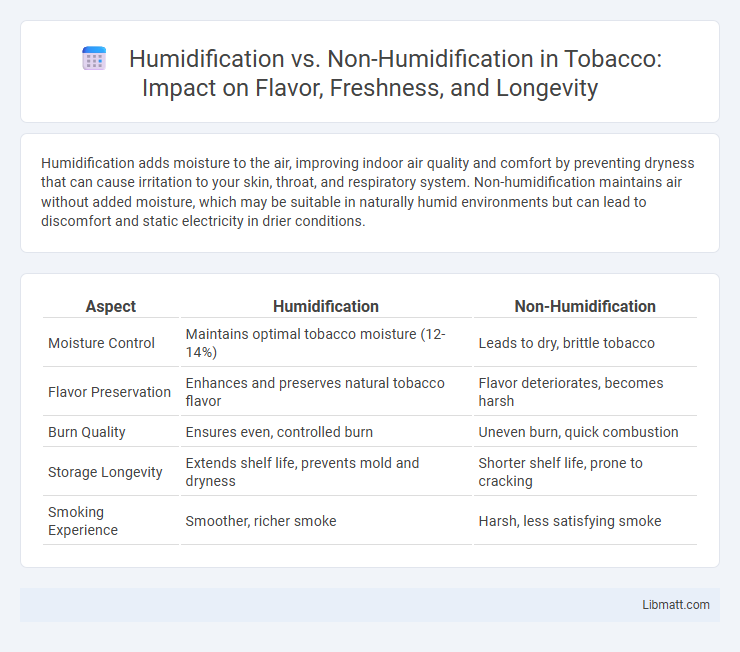Humidification adds moisture to the air, improving indoor air quality and comfort by preventing dryness that can cause irritation to your skin, throat, and respiratory system. Non-humidification maintains air without added moisture, which may be suitable in naturally humid environments but can lead to discomfort and static electricity in drier conditions.
Table of Comparison
| Aspect | Humidification | Non-Humidification |
|---|---|---|
| Moisture Control | Maintains optimal tobacco moisture (12-14%) | Leads to dry, brittle tobacco |
| Flavor Preservation | Enhances and preserves natural tobacco flavor | Flavor deteriorates, becomes harsh |
| Burn Quality | Ensures even, controlled burn | Uneven burn, quick combustion |
| Storage Longevity | Extends shelf life, prevents mold and dryness | Shorter shelf life, prone to cracking |
| Smoking Experience | Smoother, richer smoke | Harsh, less satisfying smoke |
Introduction to Humidification vs Non-Humidification
Humidification involves adding moisture to the air, which can improve indoor air quality, prevent dry skin, and protect respiratory health, especially in dry climates or heated environments. Non-humidification, by contrast, maintains natural air moisture levels, reducing risks of mold and dust mite growth but may lead to discomfort such as dry throat or static electricity during low-humidity conditions. Your choice between humidification and non-humidification depends largely on your environment's dryness and specific health or comfort needs.
Understanding the Basics of Humidification
Humidification involves adding moisture to the air to maintain optimal indoor humidity levels, typically between 30% and 50%, which helps prevent dryness that can irritate respiratory passages and skin. Non-humidified environments often experience low humidity, increasing the risk of static electricity, dry throat, and heightened transmission of airborne viruses. Proper humidification balances indoor air quality, enhancing comfort and health by reducing respiratory discomfort and protecting wooden furniture and musical instruments from drying out.
What is Non-Humidification?
Non-humidification refers to the process or practice of not adding moisture to the air, often used in controlled environments where maintaining low humidity is crucial to prevent mold growth, corrosion, or equipment malfunction. In contrast to humidification, which increases indoor moisture levels for comfort or health reasons, non-humidification systems rely on ventilation and dehumidification methods to keep air dry. This approach is commonly applied in industrial settings, museums, and data centers where precise humidity control ensures product integrity and operational efficiency.
Key Differences Between Humidified and Non-Humidified Environments
Humidified environments maintain optimal moisture levels, preventing dryness in the air that can cause respiratory discomfort, static electricity, and damage to wooden furniture. Non-humidified environments often lead to lower humidity, which may increase the risk of colds, dry skin, and irritation of the nasal passages. Understanding these key differences helps you optimize indoor air quality for comfort, health, and preservation of your belongings.
Health Impacts: Humidification vs Non-Humidification
Humidification helps maintain optimal indoor moisture levels, reducing respiratory issues, dry skin, and irritation associated with dry air, which is common in non-humidified environments. Non-humidification can lead to increased susceptibility to colds, sinus congestion, and exacerbation of asthma symptoms due to dry mucous membranes. Maintaining relative humidity between 30-50% is essential for minimizing health risks and promoting overall respiratory comfort.
Effects on Indoor Air Quality
Humidification improves indoor air quality by maintaining optimal moisture levels, reducing dryness that can cause irritation to the respiratory tract and skin. Non-humidified air often leads to static electricity buildup, increased dust circulation, and can exacerbate symptoms of allergies and asthma. Your environment benefits from balanced humidity, which supports comfort and reduces airborne pathogens.
Applications in Healthcare and Industry
Humidification plays a critical role in healthcare by maintaining optimal moisture levels in respiratory therapy devices, reducing mucosal dryness and enhancing patient comfort during oxygen delivery. In industrial settings, controlled humidification prevents static electricity buildup and maintains material integrity in processes such as textile manufacturing and electronics assembly. Conversely, non-humidified environments are utilized where excess moisture could lead to contamination or corrosion, such as in pharmaceutical clean rooms and semiconductor fabrication.
Energy Efficiency and Cost Comparison
Humidification systems generally consume more energy due to the need for water vaporization or steam generation, impacting overall operational costs compared to non-humidification environments. Non-humidified spaces typically experience lower energy usage as they avoid the additional load on HVAC systems required to maintain optimal humidity levels. Energy efficiency in humidification depends on technology type, with evaporative humidifiers often being more cost-effective than steam humidifiers in terms of both energy consumption and maintenance expenses.
Pros and Cons of Humidification and Non-Humidification
Humidification enhances indoor air quality by preventing dryness that can cause skin irritation, respiratory issues, and static electricity, but excessive humidity may promote mold growth and dust mites, posing health risks. Non-humidification reduces the likelihood of mold and mildew, beneficial in damp climates, yet can lead to dry air, increasing susceptibility to colds, influenza, and aggravating asthma symptoms. Balancing humidity levels between 30-50% optimizes comfort and health outcomes, mitigating the drawbacks of both humidified and non-humidified environments.
Choosing the Right Solution for Your Needs
Humidification enhances indoor air quality by maintaining optimal moisture levels, reducing dryness-related issues such as irritation and static electricity. Non-humidification systems conserve energy and prevent excess moisture that can lead to mold growth and structural damage. Your choice depends on balancing comfort, health considerations, and the specific climate conditions of your environment.
humidification vs non-humidification Infographic

 libmatt.com
libmatt.com